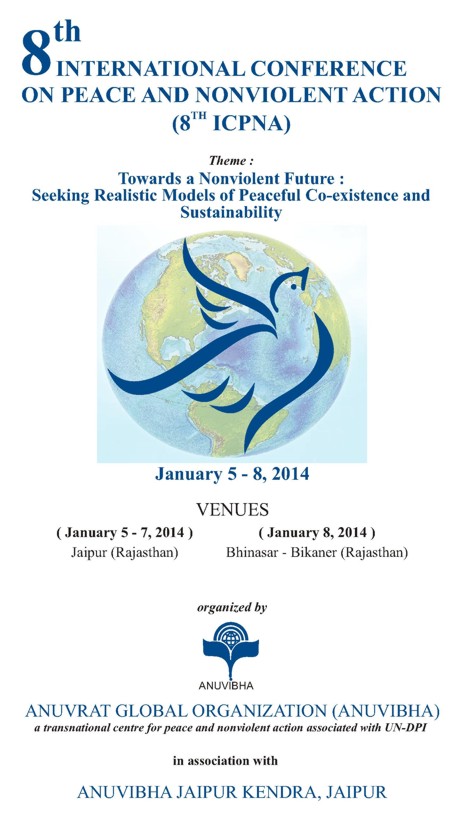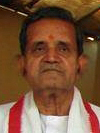 | 8th International Conference on Peace and Nonviolent Action |
How A Non-Violent Future Is Possible
Leaving aside those abnormal persons who enjoy torturing others without any purpose, we have normally to face a cut-throat competition in our day-to-day life. I had to face competition four times in my life for selection as lecturer, reader, principal and professor. Every time there were about 10 to 12 candidates, whereas there was only one post. I was selected by the interview board whereas they were not selected. Thus I became instrumental in their failure. The question is: did I commit violence in as much as I came in the way of the selection of those who were not selected?
Position of ascetic tradition
There are two answers to this question. The ascetic tradition says that all worldly pursuits necessarily involve violence. The ideal position, therefore, would be to renounce all worldly pursuits and keep your physical necessities to the minimum, fulfilling them by begging food etc. from those who offer them willingly. This concept gave birth to the ideal of a monk’s life.
Obviously the above could not be an ideal for all; even the monk has to depend on some who are not monks i.e. who are house-holders. Are these house-holders perfectly non-violent? One answer is that since they earn livelihood by means of some profession where competition is unavoidable, they cannot be perfectly non-violent. But they can try to avoid as much violence as possible. Therefore, their observance of non-violence is only partial. They are supposed to be observing small vows of non-violence, a situation from which this institution of Anuvibha derives its name i.e. Anu = small, v = vow of non-violence etc.
Position of the Gītā
The Gītā gives another alternative. It says that violence is not committed merely by the fact that if you are performing your duty and somebody has to face unfavorable situation in the process. Performance of assigned duty is necessary not only for earning one’s livelihood but also for the maintenance of the society. For example, a soldier has to fight for the defense of his country. A judge has to punish the criminal for maintaining law and order. Now, this solder or the judge can also observe perfect non-violence if they perform their assigned duty without pride or prejudice. Attachment or aversion is the real cause of violence and not the suffering of somebody. Hence it is not necessary to adopt the life of a monk for perfect observance of non-violence and a person can follow normal life as a house-holder earning his livelihood but without any attachment.
Having described the two positions regarding non-violence in short, let us concentrate on the common points which are related with non-violence. Let us also point out the present situation regarding these points as to why non-violence is not successful to the desirable extent:
- The first and foremost is the necessity of avoiding attachment and aversion, which causes tension, on one side, for the self and unjust behavior, on the other side, for others. This appears to be a very high goal, achievable by a selected few.
- From absence of attachment comes the tendency of non-possessiveness resulting in an austere life style. There could be different standards of austerity for different people but at least one can try to avoid those luxury items which are harmful to one’s own physical and mental health. Mahatma Gandhi wanted complete prohibition in India, but it could not succeed. Total vegetarianism is said to be impractical. Total disarmament also is a pious wish.
- Exploitation of the weak by the strong is the most prevalent form of violence. This has not been checked in spite of much noise about human rights and Marxism. The tendency to serve self-interest at the cost of others, is at the root of exploitation.
- Individuals and nations think of living in isolation, whereas we are so intimately inter-connected that the harm of one cannot be the gain of the other, though it may outwardly appear to be so.
- Even religion has not served its purpose in practice. Dogmatism has led to fundamentalism. More wars have been fought in the name of religion rather than for any other cause.
- Mahatma Gandhi emphasized the importance of purity of means even for a noble cause. He did not favor violent means even for the cause of getting independence for India. This ideal could be followed only partially even by such a great man as Late Shri Nelson Mandela who had to take recourse to armed struggle against the unjust system of apartheid.
- Non-violence is a holistic virtue. Non-violence means not adopting any unfair means for serving a selfish motive. Telling lies, stealing, having illicit sex, and greed are all different forms of violence. We have not paid attention to this wider aspect of non-violence, limiting it to absence of war or vegetarianism or ecological considerations.
The way out
The soul in its pure stateHaving enumerated some important hurdles which face observance of non-violence, let us think of a way out.
The remedy lies in one word—spiritualism. Spiritualism means looking inward. When we look inward we find that we are living in an inner world of disharmony between the good and the evil. We try to overcome the evil by good. But normally the reverse of it happens; the evil overcomes the good. We live in a dilemma - the struggle between the good and the evil has no end.
Spiritualism means rising above good and bad. The Sanskrit word for religion is dharma. Dharma means nature of things. Nature of a thing is as it is - it is neither good nor bad. The nature of the body is mortality; the nature of soul is immortality. When we look outside, we find that everything is perishable. We try to preserve the body for ever. It is against the law of nature. When we look inside we find that there is something which does not change. We call it soul.
The soul is described in the following manner: It has no color; no taste; no smell; no touch; no gender; no body-form and no bone-structure. All these states of beings are described from the empirical point of view. From the real point of view, all souls are perfect in nature. Soul is indescribable and possessed of consciousness. It is not amenable to inferential cognition and is devoid of bodily structure. The pure soul is free from activities of thought, speech and body. It is independent, infallible and fearless. It is also free from attachment and delusion. The pure soul is free from complexes, attachment, blemishes, desire, anger, lust and all others kinds of defects. The state of pure knower is neither vigilant nor non-vigilant (because vigilance means absence of passions and non-vigilance means presence of passions and the question of absence or presence of passion is irrelevant in case of soul). The knower-self is called pure, it is only knower and nothing else. The soul is neither the body, nor the mind nor the speech, nor their cause. Nor is it doer, nor it is the cause of action, nor the approver of action. I am alone, really pure and free from attachment. I have the faculties of apprehension and of comprehension. Being steadfast in concentrating the real nature of self, I discount all those forms that are alien to me.
Knowledge itself only reflects the objects. It is not polluted by that reflection. Therefore it remains unaffected by what goes on in the world. Therefore it is ever free. Space and time are the two important frameworks of physical world. Matter exists in time and space but not the soul.
The result of self-realization
The feeling-realization of this nature of soul opens the doors of an altogether different kind of world.
Attachment to worldly things appears to be of no significance. We eat to live and do not live to eat. When one realizes one’s own self, one starts recognizing the same soul in others also. Here comes the true sense of equality. One’s soul is neither smaller nor bigger from another’s soul. All souls are equal. Every creature is a goal unto itself, nobody is a means for achieving my goal. I can only help it, but cannot use it for meeting my selfish end.Soul is immortal. From it follows absolute fearlessness. There is no necessity of trying to survive by fair or foul means. There is nothing favorable or unfavorable for the soul. Therefore, there is no scope for anger on meeting something unfavorable. There is no necessity of hypocrisy or greed, no question of pride or prejudice.
It is on this self-realization that the real foundation of non-violence is laid. Everything else - social or political - follows automatically.
The present scenario
The world is in search of permanent solution. Therefore, Yoga and meditation are becoming so popular. It is a welcome trend because Yoga is the only method of self-realization. Yoga is neither a religion, nor a philosophy, nor a theology, nor a ritual; nothing else except realizing who I am. Then a non-violent future is surely possible.
It one sentence, when we act for the sake of joy, we commit violence because, we expect joy from others - animate or inanimate - and use them as means by subjugating them, but when we act out of joy, we are non-violent because we don’t seek anything from others, giving them full freedom; we only manifest our inner joy. Let us act out of joy and not for joy. And the whole world changes from violence to non-violence.
 Prof. Dr. D.N. Bhargava
Prof. Dr. D.N. Bhargava